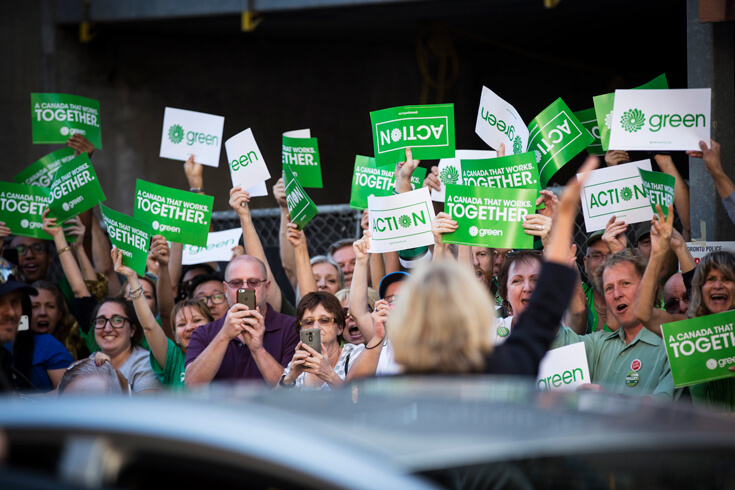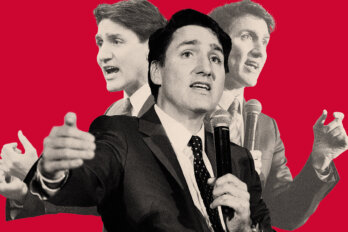NDP candidate Bob Chamberlin’s best moment in the Nanaimo by-election this spring may have come after he conceded to the Green Party’s Paul Manly. Speaking to a local newspaper, Chamberlin joked that his campaign’s turning point came when the votes were being counted.
That turning point, in fact, may have come before he was even nominated. Signs were the first sign. Our block has long been a sea of orange at election time. This time, I spotted five or six Manly Green Party signs as soon as the by-election was called—and not a single NDP placard. The NDP had been caught flat-footed: not expecting the by-election call, they hadn’t yet nominated a candidate. Even weeks later, there was just one NDP sign on our block. What was happening?
The Greens’ by-election win had much to do with national issues, but the local campaign played a role too. Chamberlin was evidently the preferred candidate of the NDP brass, winning the nomination over local activist Lauren Semple. But the nomination meeting attendance—just under 400—also signalled trouble for the party. Chamberlin has an accomplished background as a First Nations leader and helped broker a 2018 deal to mitigate the impact of coastal salmon farms on wild salmon. But, as a speaker, he was often rambling and vague; he turned out to be an uninspiring candidate.
John Hirst, the manager of a local Sun Life Financial office, ran a competent but unremarkable campaign for the Conservatives. The Liberals, represented by Nanaimo Port Authority director Michelle Corfield, were largely invisible. There seemed to be more Team Trudeau signs in vacant lots than on the lawns of proud supporters.
The Greens’ campaign was as strong as the NDP’s was weak. Manly has deep roots in the riding and campaigned tirelessly. A solid rather than charismatic speaker, he was well informed and well liked. In 2015, he’d taken almost 20 percent of the vote. This time, Manly won with more than 37 percent. (The Conservatives held at 25 percent, while the NDP dropped to 23 percent from 33 percent in 2015, and the Liberals fell precipitously to 11 percent.)
Given the margin of victory, anyone-but-Conservative strategic voters in Nanaimo–Ladysmith will now likely go Green in October too. But what are the Greens’ prospects beyond the borders of this riding? In Ontario, they have quietly risen some distance in the polls this year. Elsewhere, they have polled at three to four times the support they received in 2015. In Saskatoon, a recent poll by the University of Saskatchewan’s Social Science Research Laboratories put support for the Green Party at a surging 8 percent, just two points behind the NDP. In Quebec, Daniel Green (one of the party’s two Deputy Leaders) made a sufficiently impressive showing in February’s Outremont by-election for Marie Vastel of Le Devoir to suggest there could be a vague verte in 2019 to parallel the vague orange of 2011. NDP MP Pierre Nantel’s August defection to the Greens is, as Eric Grenier has written, a sign of how far the NDP has fallen in Quebec since its 2011 rise under Jack Layton.
Across the country, the Greens have recently excelled at fundraising: in the second quarter of 2019, for the first time, the party raised more in donations than did the NDP. And the Greens have also significantly strengthened their organizational capability. Nanaimo suggested, among other things, that Greens are capable of doing a better job than New Democrats of identifying their voters and getting them to the polls. These are all signs that, come election day, the Greens could be poised for a breakthrough.
No matter how strong a party’s organization may be, party leadership remains crucial. Elizabeth May is a known quantity in Canadian politics—known and well respected. What do we know of Jagmeet Singh, whose new book, Love and Courage, spent several weeks this spring on the Canadian bestseller list? His memoir is a highly readable book of real merit. He unflinchingly shows the damage that alcoholism can wreak within a family: the story of his father’s tragic fall and eventual recovery takes up much of the book and is consistently compelling. Just as detailed is Singh’s account of the abuse he suffered at the hands of his martial-arts coach. Even those who find it hard to imagine how child molesters draw in their prey will understand the process all too clearly after reading Singh’s chilling description.
Though Love and Courage includes a prologue and an epilogue that tie the book in with politics, it is a personal memoir rather than a political autobiography. That said, it does offer clues to the puzzle Singh has become as NDP leader. Why has his genuine personal appeal failed to translate into popular support? How can someone so evidently intelligent and well spoken have had so many moments of baffling incompetence? Is he poorly briefed? Or is this transparently decent man simply out of his depth as a national party leader? The experience of reading Love and Courage suggests another possibility: Singh may be temperamentally inclined toward binary thinking—and disinclined to come to grips with issues that resist easy solutions. One striking aspect of Love and Courage is that the incidents Singh selects from his life history (dealing with childhood bullies, with police profiling, with racist heckling) are situations of striking moral clarity. How to face the bullies and the haters? With love, not hate; courage, not fear.
This is, again and again, the book’s message, and it is at the core of Singh’s political messaging as well. (At rallies, half the crowd is coached to shout, “Love,” the rest to respond with, “Courage.”) One can hardly quibble with that message itself—and we should admire Singh for the way he’s responded to provocation. But a comparison here with Barack Obama—another lawyer/activist/politician who endured racism and had to come to terms with the legacy of a father with a drinking problem—may be instructive. In his 1995 memoir Dreams from My Father, Obama writes of overcoming fear and combatting racism, but he also recounts times when problems couldn’t be solved purely by finding the courage to do what was obviously right: he offers real insight into how life and politics often resist easy solutions. Singh’s record as leader, by contrast, suggests he tends to become unsure of himself when things become complicated.
Things do become complicated, of course, with just about any large and controversial issue. It now seems certain that the environment will be among the most important issues of the fall campaign—as it was in Nanaimo–Ladysmith this spring. But what do people mean by “the environment”?
I spoke with a number of first-time Green voters in Nanaimo who didn’t have lists of specific environmental issues; they simply wanted to send a message that attention should be paid to the environment, and they felt that the NDP and other parties hadn’t paid enough attention.
Others within the Green party did have specific complaints— chief among them Singh’s support for John Horgan’s LNG Canada pipeline plans. The business of fracking gas in northern BC, shipping it via pipeline to the coast, then liquefying it for shipment to Asia is a national issue as well as a provincial one, and it’s one that tends to divide New Democrats. Natural gas is a cleaner fuel than bitumen, but it’s still a fossil fuel, and the fracking that produces it is a nasty business. Elected First Nations councils across the pipeline route support the project, but a group of hereditary chiefs opposes it. For Singh to speak out against the pipeline would please his party’s green wing, but it would go against a popular NDP premier—and play into the hands of right-wingers who claim the NDP always says no to jobs. In short, it’s a difficult, multifaceted issue—and tricky territory for Singh. And how has he responded? During the by-election campaign, he was still on record supporting the LNG pipeline, though he rarely brought the subject up. (Svend Robinson publicly interpreted the NDP’s by-election loss as largely a vote against LNG.) After the by-election, Singh came out against fracking. Then, when Vassy Kapelos repeatedly asked him about the LNG pipeline on Power and Politics, he simply refused to answer—responding three times with a stock line not about LNG but about the Trans-Mountain pipeline. (“I tried,” said an obviously frustrated Kapelos.) Since then, the NDP has released a “new deal for climate action and good jobs” that says nothing about the LNG pipeline—or about opposing fracking in general.
Animal agriculture was another environmental issue raised this past spring in Nanaimo. (Like many cities, it’s home to a fast-growing community of vegetarians and vegans.) But, in political and policy terms, animal agriculture is another issue without easy solutions. We humans are blessed with the ability to make ethical choices about what we eat, and with digestive systems that can accommodate almost any diet. We can choose diets that are good for our health (the new Canada’s Food Guide emphatically de-emphasizes meat and dairy); that are good for the environment (according to Beyond Meat—the Los Angeles–based producer of plant-based meat substitutes—a Beyond Burger takes 99 percent less water and 93 percent less land to produce than a beef burger); and that don’t involve causing harm to animals. Or we can choose diets that entail cruelty to animals, are worse for the planet, and are worse for our health. Better health through better eating, of course, also means lower health-care costs, fewer workers on disability, fewer forced to retire before they’d like to—and, in turn, less strain on our pension system and less burden on taxpayers as the population continues to age.
It’s hard to find greater moral clarity than that—and, as individuals, both Singh and Elizabeth May seem to understand this. Singh writes, in Love and Courage, that “the ethical treatment of animals, reducing [his] carbon footprint, and protecting the environment” are his motivations for maintaining a vegetarian diet. May is largely vegetarian too, though she eats some seafood.
The complicated part is how to deal with the issue politically when roughly 90 percent of Canadians eat meat. Most voters don’t think about agricultural policy when they think about climate change, and it’s been my experience that political parties have long assumed no votes will be gained by siding against farming—even the factory farming of animals. Like LNG, it’s a difficult issue for the federal NDP, which wants to protect the status quo through supply management and direct industry subsidies. As with LNG, Singh seems not to know which way to turn. When I asked him about the issue during the Nanaimo campaign, he trumpeted his own vegetarianism. “But what about policies?” I asked. “That’s something I’ve started to think about,” he responded. When we ran into each other again, a few weeks later, I asked him if his thoughts were leading anywhere. “I’m still thinking about it,” he assured me. For the moment, NDP agriculture and food polices say nothing whatsoever about trying to reduce Canadians’ consumption of animal products.
It’s a difficult issue for the Greens too. Their official policy is to move away from factory farming. But the Greens are a party of individuals rather than of groupthink: they are resolved not to enforce rigid party discipline on MPs no matter how many are elected. Individually, Green Party members acknowledged the need for policy changes to me in a series of email exchanges. Manly expressed his unequivocal opposition to government subsidies for factory-farmed animal agriculture and made clear that, while he does not want “to tell people what to eat,” he supports “policies to encourage Canadians to eat a plant-based diet.” Deputy Leader Jo-Ann Roberts (the party’s candidate in Halifax) is confident that the Greens “will be advocating for more plant-based diets” and “more sustainable, local agriculture production” as they update their agriculture and food-security policies. For her part, May insists that the Green Party as a whole “does promote a policy of eating less animal protein”; she adds that, in her view, “we must transition to a more plant-based diet as part of the fight to combat climate change.”
That point about climate change is a telling one. Numerous recent studies have confirmed the impact of animal agriculture on global warming: 23 percent of greenhouse-gas emissions can be attributed to animal agriculture and the deforestation that goes along with it. While conducting the largest of those studies, Joseph Poore of Oxford University became convinced, according to an article in the Guardian, that “a vegan diet is probably the single biggest way to reduce your impact on planet Earth.”
The case for new directions in food and agriculture policy is becoming ever stronger—sufficiently so that Greenpeace is now calling for a worldwide effort to cut meat and dairy production and consumption in half by 2050. But, among Canadian political parties, only the Greens have even begun to negotiate the shifting ground on what remains a difficult and complicated political issue. May and the Greens seem to sense something that Singh and the NDP haven’t picked up on: it’s no longer political suicide for a party to acknowledge (and try to address) the harms done by animal agriculture. A recent survey to determine Canada’s attachment to meat consumption reported that 2.1 percent of Canadians self-identify as vegetarian, with a further 10.2 percent describing themselves as “flexitarian” or “vegetarians who occasionally eat meat and fish”—add vegans, and that’s almost 17.4 percent of the country. And, of those Canadians who do eat meat, fully 51 percent reported that they were willing to consider reducing their meat intake.
All these numbers are growing. In Nanaimo, the Vegans of Nanaimo Facebook group has grown from fifty members when it was created in 2013 to over 1,200 members today. (The rival group Vegan Eats in Nanaimo, created four years ago, now has over 500 members.) Not by coincidence, Green Party support among young people has been growing quickly as well. Abacus Data reported this year that “the potential Green voter pool is . . . a whopping 58 percent among those under thirty.” The NDP chose Singh, at least in part, in the hope that his youth and stylishness would appeal to young people. But—as the American campaigns of Elizabeth Warren and Bernie Sanders attest—young people in 2019 may be more interested in substance than in youthfulness and style. Of course, if Elizabeth May’s support among under-30s continues to grow, it won’t be the first time that a principled, sure-footed Canadian politician who’s been around for a while finally catches on with young people. The 2011 election was Jack Layton’s fourth as NDP leader, and he was sixty.
If there are interesting similarities between May and Layton, there are also striking contrasts. It’s often forgotten that the era in which the NDP leader’s office exerted powerful control over the party began well before Tom Mulcair: under Layton as well, MPs were kept on short leashes, and messaging was tightly controlled. The Green Party, on the other hand, stresses both its commitment to not muzzle MPs and its overarching commitment to openness. It’s all too easy to be cynical about modern political parties making such commitments, but my experience over the past year of trying to contact people in both parties suggests that the Greens really are different. I’ve still not received a response to an email on one issue that I sent last fall to Singh and fellow MPs Murray Rankin and Ruth Ellen Brosseau. Nor have I received responses to two emails on separate issues that I sent to Chamberlin during and just after the Nanaimo campaign. (Of the NDPers I emailed for this article, only Svend Robinson responded.)
In contrast, every Green I’ve contacted has been responsive and courteous. May has repeatedly and helpfully answered questions, as have Roberts and Manly. (During the by-election campaign, Manly responded very late one evening, at substantial length, to an email I had sent him earlier that same day.) In a political atmosphere now tainted by the Liberals’ perceived failure to follow through on their 2015 campaign promise to restore “a sense of trust in our democracy” through “greater openness and transparency,” Canadians in 2019 may well be drawn to a party that sincerely commits to openness.
All Green parties fight against the perception that they are one-issue parties. In fact, the Green Party of Canada has a set of policies at least as comprehensive as those of any old-line party. But, if the response to “the Greens are a one-issue party” is “check online—they have policies on almost every issue,” eyes understandably glaze over. That’s part of the reason why a guaranteed livable income is high on the Greens’ list of October priorities. Having now spoken to many people in Nanaimo (including several who ended up not voting in the by-election), I can attest to the difference such a policy can make in the minds of undecided voters.
Ever since the 1960s, informed voices across the political spectrum (from Martin Luther King to Progressive Conservatives Robert Stanfield and Hugh Segal to NDPer Guy Caron) have argued that a guaranteed livable income (as the Greens style it—it’s also known as a “guaranteed annual income” or “universal basic income”) is both the most effective and the most efficient way to address poverty. “A basic income will actually save us money,” Caron argued back in 2017, since “less poverty means less stress on health care, social programs, and public-safety resources.” Doug Ford killed Ontario’s basic-income pilot project, but BC has created a committee to study the potential for basic income, and the concept continues to attract adherents across the country. The Greens have long supported a national guaranteed income, but this year, they are giving it more prominence—making it far more difficult for critics to paint them as a one-issue party.
The people who are likely to benefit most from a guaranteed income are renters—and, at election time, they tend not to put signs of any sort out front. But, in Nanaimo, quite a few low-income, traditionally NDP voters were among those who voted Green in May. I’ve spoken now with many of the by-election’s quiet Green voters—people from a range of backgrounds who did not broadcast their voting intentions with a sign outside their houses or apartments. They include people who’d previously voted strictly NDP but had come to see that party as too hung up on identity politics; people who’d voted for an old-line party last time but had come to see those parties as too deeply in the pockets of big business or big labour; people who’d voted Conservative last time but had come to feel the Conservatives just weren’t being honest about climate change and the environment; and people who’d voted Liberal last time but had come to feel the Liberals just weren’t being honest about anything.
How well could the Greens actually do in October? Is it conceivable that Elizabeth May could become leader of the official opposition—or, even, if the vote splits four ways in English Canada and five ways in Quebec, prime minister of a minority government? A week before the leaders’ debate in 2011, polls showed Layton’s NDP at 15 to 21 percent; on election day, the party took 31 percent of the votes. Amazing things can happen.






